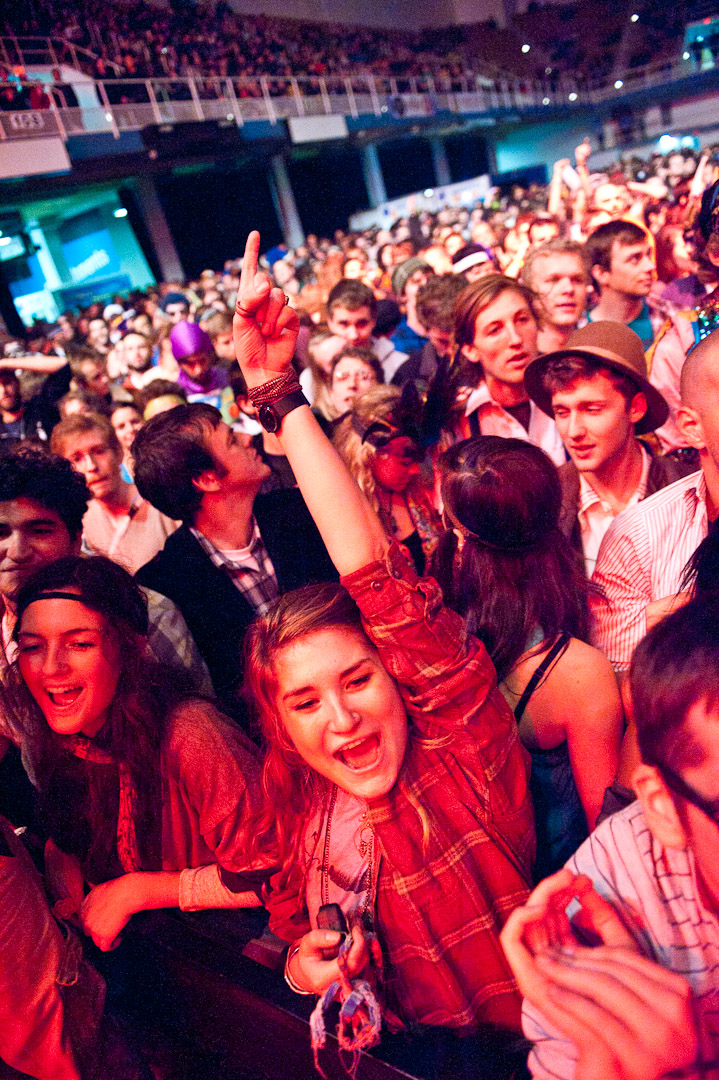Fun is serious business: Moogfest organizers estimate the festival will bring $30 million to the area in April. Photo of a Moogfest 2012 crowd by David Simchock.
Tourists spend about $1.5 billion in Buncombe County every year and the fourth annual Creative Sector Summit will explore opportunities for local artists to raise that number and better benefit from it. The series of panel discussions, workshops and other events will unfold Thursday-Sunday, March 20-23, at venues throughout downtown Asheville.
This year’s theme is “creating economic vitality through arts and tourism,” says organizer Kitty Love, executive director of the Asheville Area Arts Council. More than 9 million yearly visitors come to Buncombe County, she says, and that provides a major customer base for local creative businesses. But, Love says, she keeps “seeing a disconnect … between our wonderful talented artists, and the visitors who come to the area.
“And I feel like there is an opportunity here for folks who are making creative products, whether it’s performance or visual arts, to be more visitor-ready. And to find a way to access the market opportunity that those 9 million people coming to the county every year represent,” Love explains.
One new opportunity that will be unveiled at the summit is a collaboration between the Arts Council and the Asheville Convention and Visitor’s Bureau (CVB). They’re working to build a new, comprehensive online calendar of creative happenings on the highly-trafficked exploreasheville.com site, which serves as a planning hub for visitors. Creative individuals and organizations will be able to post profiles and event information free of charge, directing potential new customers their way even before they set foot in town.
“It’s a comprehensive opportunity for arts and culture,” says Love. “It’s a pretty big deal. We’re hoping for wide participation, from little tiny circus groups and schools to the major cultural anchors such as the Art Museum.”
Although Love says that in the past artists have sometimes been viewed by leaders as the “red-headed stepchild” of the local economy, she sees the new site as a sign that things are moving in the right direction.
“The CVB is putting their money where their mouth is in creating this free opportunity for artists through this web portal,” she says.
Creative new future
There’s at least one compelling reason the mainstream economic development community has started taking local artists more seriously in recent years: A 2010 study by Americans for the Arts found that the nonprofit arts-and-culture industry generated $43.7 million in economic activity in Buncombe County. That money — $16.9 million spent by local nonprofits and another $26.8 million from audiences at arts events — supported 1,427 full-time-equivalent jobs, generated $32.5 million in household income for local residents and delivered $4.8 million in local and state government revenue.
Those numbers don’t include the economic activity of artistic entrepreneurs and private businesses. In fact, one of the major challenges facing the creative community is quantifying its financial impact, says Love.
The Economic Development Coalition of Asheville-Buncombe County (EDC) has targeted the arts and culture sector as poised for growth. And the group does have some data to back that up: The industry grew 17 percent from 2005-2011, employing 6,500 people at the end of that year. The craft business alone generates more than $206.5 million a year in Western North Carolina, according to the EDC. Moogfest organizers estimate the music and innovation festival will bring $30 million to the area in April.
However, Love laments, “We really don’t have enough numbers on the economic impact on the commercial side” of the arts industry. She hopes that the summit will help cultivate a push to fund a comprehensive new economic development study. An up-to-date and fuller picture of the industry could be a valuable tool in charting a future course, she says. There’s currently no good measure of how much tourism revenue is generated from artists and ends up in their pockets.
One of the best things to come out of the annual summits so far, says Love, is last year’s formation of the Buncombe Cultural Alliance. Made up of a range of local arts, government and business leaders, the group’s mission is to “ensure the health of arts, culture and entertainment in Buncombe County … through advocacy, and through the creation of community and economic development strategy.” They’ve been working on writing a document that could eventually provide the backbone of an Arts and Culture Master Plan. They’ll present a draft and solicit feedback from the public at the Summit.
Such a plan would provide “a strategic way that local governments can invest in arts, culture and entertainment,” says Love.
Taken together, the Summit and related initiatives are all part of “shining a light on arts and culture as a tool for building great community,” she adds. “We’re trying to create a comprehensive conversation.”
For a comprehensive list of Creative Sector Summit events and registration details visit ashevillearts.com/creative-sector-summit-2014.




Before you comment
The comments section is here to provide a platform for civil dialogue on the issues we face together as a local community. Xpress is committed to offering this platform for all voices, but when the tone of the discussion gets nasty or strays off topic, we believe many people choose not to participate. Xpress editors are determined to moderate comments to ensure a constructive interchange is maintained. All comments judged not to be in keeping with the spirit of civil discourse will be removed and repeat violators will be banned. See here for our terms of service. Thank you for being part of this effort to promote respectful discussion.